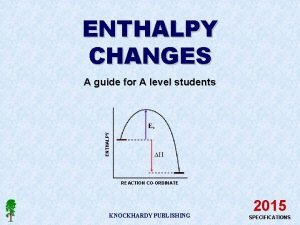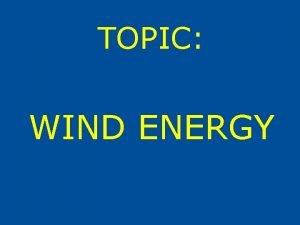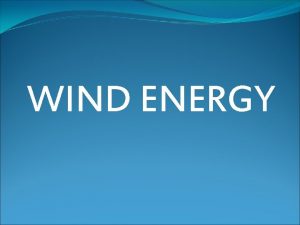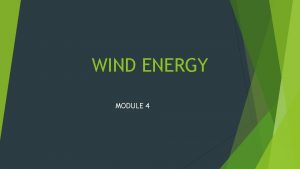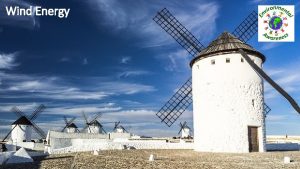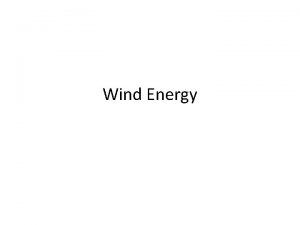Wind Energy The wind emanate from the changes






- Slides: 6

Wind Energy The wind, emanate from the changes and different from place in place, prices of atmospheric pressure. This different prices of pressure are owed in the different heating (absorption of energy) the atmosphere of each place from the sun. The wind realized it is possible to turn windmills , to move boats and vehicles or to move objects, to give us that is to say energy. This energy, Aeolian ([Aeolus] was the “administrator of” winds, at the ancient `Greek), is developed in our days continuously more, in regions where often blow powerful winds. The exploitation of Aeolian energy is lost in depths of history. For many hundreds years the movement of boats was supported in the force of wind, while the use of windmill as motive machine is abandoned hardly in previous century. The petrol crisis in the beginning of decade the 70, brings again in the limelight the soft energies and the Aeolian (Wind) energy. Becomes henceforth conscience in more and more world, that the wind is a clean inexhaustible source of energy. For the exploitation of Aeolian energy we today use the wind generators, with which is changed the kinetic energy of wind in electric. The house of winds under acropolis of Athens

Human has exploited the aeolian energy from early in history. The aeolian energy was used for first time for the movement of boats. The Chineses, Persians, the Greeks and the Egyptians have mainly used the windmills for a lot of centuries B. C. and for the grinding of cerials. Concretely Persians, used windmills of vertical axis. Moreover, the windmills they was used for pumping of water. This application existed mainly in Holland where the windmills they was used for the pumping of water from the flooded regions and their transport in the sea. In Greece the windmills of pumping of water (roughly 6000) they was used mainly in Eastern Crete. In 1900, Danes produced electricity from the wind. In 1940 in Vermont (USA) was manufactured a test wind generator with two fins. But the aeolian energy was not considered important up to the decade the 70 ' when realized the energy and environmental problem of our planet and tried to redesign the wind generator. Old wind mills (Aegean islands)

A provision of wind generators is named aeolian park. In a aeolian park each wind generator has three long fins. When the fins are turned with the wind, they give movement in the generator that produces electricity. The wind however is very changeable. The changes in the direction in any case are faced easily. Only that it needs it is some system that keeps the fins of windmills in the right place. The total exploitable aeolian potential of Greece can cover a big part of her electric needs. The machines with which we exploited this phenomenon, are named wind generators. We distinguish two types: two blades and three blades.

Wind farms are built in flat, open areas where the wind blows at least 14 miles per hour. Iowa currently has more than 600 wind turbines, producing enough electricity to power 140, 000 homes. Minnesota and Wisconsin are also home to wind farms – and the number is growing every day. Using the wind to create electricity has been around for a long time – you've probably seen windmills on farms. When the wind turns the blades of a windmill, it spins a turbine inside a small generator to produce electricity, just like a big coal power plant. A windmill on a farm can make only a small amount of electricity – enough to power a few farm machines. To make enough electricity to serve lots of people, power companies build "wind farms" with dozens of huge wind turbines.

They sure are big! When it comes to size, bigger is better – the bigger the wind turbine, the more wind it reaches and the more electricity it produces. The turbines at Flying Cloud Wind Plant in northwest Iowa are about 240 feet tall. The largest wind turbine in the world, located in Hawaii, stands 20 stories tall and has blades the length of a football field! The tower is usually hollow and made of steel. The blades, called rotors, are made of fiberglass and polyester. A wind farm might have only two or three turbines, or it could have as many as 150 spread across a big field

How a wind turbine works A wind turbine works the opposite of a fan. Instead of using electricity to make wind, a turbine uses wind to make electricity. The wind turns the blades, which spin a shaft, which connects to a generator and makes electricity. The electricity is sent through transmission and distribution lines to a substation, then on to homes , business and schools. Wind turbines have an emergency shutoff if a wind storm or tornado happens. The diagram below shows some of the pieces and parts inside a wind turbine:






